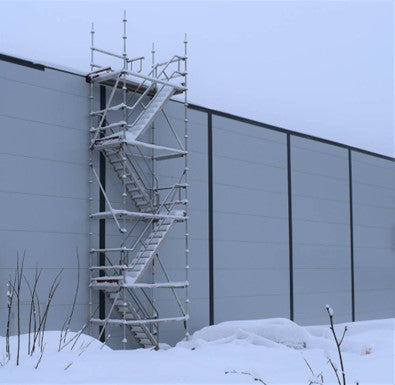Scaffolding is a job which involves working at height, so it comes with a list of safety measures which you need to consider. When the temperature drops, and the days get shorter, further precautions need to be taken into consideration when potential hazards could crop up at any moment. This might leave you wondering whether or not it’s actually safe for scaffolders to work over the worst of winter.

Winter in New England is quite unpredictable. Scaffolding in winter has its own challenges for construction and other scaffolding-related projects. With the prospect of heavy rain, strong winds, frost and the occasional snowfall, it can be a particularly problematic time for scaffold structures. Additionally, safety becomes a prime concern for workers and personnel. Ensuring the safety of your scaffolding is crucial to prevent accidents, delays and costly damages. In this blog article, we will share the essential tips for scaffolding in the winter to tackle the cold weather and to ensure smooth-running construction projects.
REGULAR INSPECTIONS ARE KEY
Before the winter season sets in, conduct a thorough inspection of your scaffolding structures. Check for any signs of wear and tear, loose fittings or damaged components. Pay extra attention to the base plates and make sure they are secure. Regular inspections will help you identify and address potential issues before they escalate.
ANTI-SLIP MEASURES
Winter brings slippery conditions, and working on scaffolding can become dangerous for workers and other personnel. To combat this, consider installing anti-slip materials on the scaffold boards and staircases. Anti-slip mats, grip-enhancing coatings and cleated scaffold boards can provide additional grip, reducing the risk of falls and accidents due to slippery surfaces.
MONITOR THE WEATHER
While we can’t predict the weather, we can stay updated on the latest weather forecast. High winds, freezing rain and snow can compromise the stability of your scaffolding structure. It’s crucial to monitor weather conditions on a daily basis and take appropriate precautions, such as lowering scaffolding heights or suspending work during extreme weather conditions.
DE-ICING AND SNOW REMOVAL
When snow and ice has covered your scaffolding structure, it can add significant weight and weaken the structure. Remove snow and ice regularly using appropriate tools, such as snow shovels or pre-treat the area with a suitable de-icing agent. Ensure walkways and access points are clear from ice or snow to prevent slips and falls. Gritting walkways with rock salt can help prevent black ice and add underfoot grip. Otherwise, if walkways or access points are unsafe, it might be worth creating a detour if possible or closing the area off to workers until the conditions have improved.
PROPER APPAREL, SAFETY GEAR AND PPE
Workers on scaffolding should be equipped with the proper apparel and personal protective equipment (PPE) all year around, particularly during the winter. When working at heights in the winter, it can feel colder. Thermal clothing, waterproof jackets, anti-slip steel toe cap boots and insulated gloves can protect workers while working in the chilly outdoors. Additionally, anti-fog goggles can maintain clear visibility during foggy conditions.
LIGHTING
Working on a scaffolding project in winter means the days are shorter. So, can scaffolders work in the dark? We recommend avoiding scaffolding work in the dark, as it can create serious hazards, and workers may not even be able to spot a hazard.
With shorter daylight hours in winter, adequate lighting is essential to maintain clear visibility. Install LED lights around the scaffold structure to ensure that workers can see clearly and navigate safely, especially during early morning, late evening or night shifts. There are many lighting options available, from LED floodlights and light towers to spotlights and barrier safety lights.
COMMUNICATION & TRAINING
Effective communication is vital in winter conditions. Ensure your team is well-informed about safety protocols, including emergency procedures. Regular safety trainings and reminders can help reinforce the importance of safety during the winter months. Additionally, fall protection is always a top priority in scaffolding no matter the season, but it becomes even more critical in winter. Ensure all workers are properly trained in fall prevention and are equipped with harnesses, lanyards, and other necessary safety gear. Properly anchor fall protection systems and secure points can help prevent accidents due to foggy, icy or wet conditions.
To summarize all above, scaffolding in winter requires careful planning, regular inspections, additional safety measures and a strong commitment to safety from both workers and management. By applying these safety tips, you can ensure your scaffolding projects proceed smoothly and safely throughout the colder months, helping you deliver successful projects while protecting your workers and the public.
At American Ladders and Scaffolds, our top priority is the safety of workers and public at all times.


